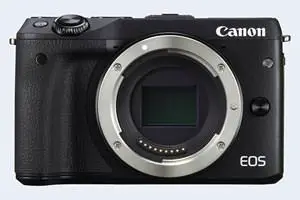Canon M3 vs Nikon D4S
The Canon EOS M3 and the Nikon D4S are two digital cameras that were announced, respectively, in February 2015 and February 2014. The M3 is a mirrorless interchangeable lens camera, while the D4S is a DSLR. The cameras are based on an APS-C (M3) and a full frame (D4S) sensor. The Canon has a resolution of 24 megapixels, whereas the Nikon provides 16.2 MP.
Below is an overview of the main specs of the two cameras as a starting point for the comparison.

Check M3 offers at
ebay.com

Check D4S offers at
ebay.com
Going beyond this snapshot of core features and characteristics, what are the differences between the Canon EOS M3 and the Nikon D4S? Which one should you buy? Read on to find out how these two cameras compare with respect to their body size, their imaging sensors, their shooting features, their input-output connections, and their reception by expert reviewers.
Body comparison
The side-by-side display below illustrates the physical size and weight of the Canon M3 and the Nikon D4S. The two cameras are presented according to their relative size. Three consecutive views from the front, the top, and the rear side are shown. All width, height and depth dimensions are rounded to the nearest millimeter.
The M3 can be obtained in two different colors (black, white), while the D4S is only available in black.
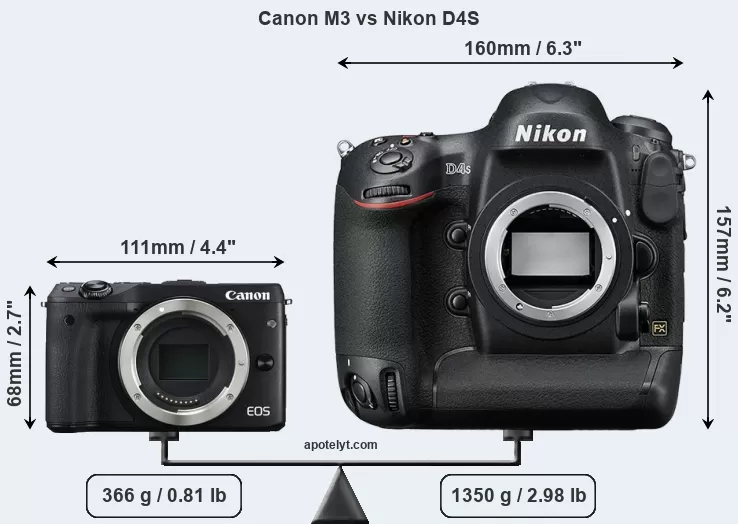
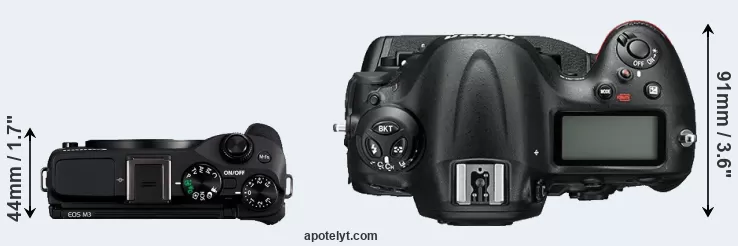
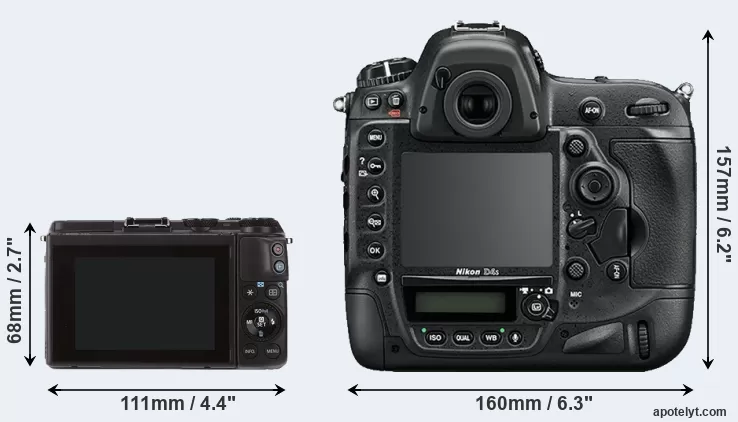
If the front view area (width x height) of the cameras is taken as an aggregate measure of their size, the Nikon D4S is considerably larger (233 percent) than the Canon M3. Moreover, the D4S is substantially heavier (269 percent) than the M3. It is noteworthy in this context that the D4S is splash and dust-proof, while the M3 does not feature any corresponding weather-sealing.
The above size and weight comparisons are to some extent incomplete since they do not consider the interchangeable lenses that both of these cameras require. Hence, you might want to study and compare the specifications of available lenses in order to get the full picture of the size and weight of the two camera systems.
Concerning battery life, the M3 gets 250 shots out of its Canon LP-E17 battery, while the D4S can take 3020 images on a single charge of its Nikon EN-EL18a power pack. As can be seen in the images above, the D4S has a battery grip built in. This facilitates image-taking in portrait orientation and gives it additional battery power.
The table below summarizes the key physical specs of the two cameras alongside a broader set of comparators. In case you want to display and compare another camera duo, you can use the CAM-parator app to select your camera combination among a large number of options.

| Camera Model |
Camera Width |
Camera Height |
Camera Depth |
Camera Weight |
Battery Life |
Weather Sealing |
Camera Launch |
Launch Price (USD) |
Street Price |
||
|---|---|---|---|---|---|---|---|---|---|---|---|
| 1. | Canon M3 | 111 mm | 68 mm | 44 mm | 366 g | 250 | n | Feb 2015 | 679 | ebay.com | |
| 2. | Nikon D4S | 160 mm | 157 mm | 91 mm | 1350 g | 3020 | Y | Feb 2014 | 6,499 | ebay.com | |
| 3. | Canon G5 X | 112 mm | 76 mm | 44 mm | 353 g | 210 | n | Oct 2015 | 799 | ebay.com | |
| 4. | Canon G7 X | 103 mm | 60 mm | 40 mm | 304 g | 210 | n | Sep 2014 | 699 | ebay.com | |
| 5. | Canon M | 109 mm | 66 mm | 32 mm | 298 g | 230 | n | Jul 2012 | 599 | ebay.com | |
| 6. | Canon M5 | 116 mm | 89 mm | 61 mm | 427 g | 295 | n | Sep 2016 | 979 | ebay.com | |
| 7. | Canon M6 | 112 mm | 68 mm | 45 mm | 390 g | 295 | n | Feb 2017 | 779 | ebay.com | |
| 8. | Canon M50 | 116 mm | 88 mm | 59 mm | 390 g | 235 | n | Feb 2018 | 779 | ebay.com | |
| 9. | Canon M50 Mark II | 116 mm | 88 mm | 59 mm | 387 g | 305 | n | Oct 2020 | 599 | ebay.com | |
| 10. | Canon M100 | 108 mm | 67 mm | 35 mm | 302 g | 295 | n | Aug 2017 | 499 | ebay.com | |
| 11. | Canon T6i | 132 mm | 101 mm | 78 mm | 555 g | 440 | n | Feb 2015 | 749 | ebay.com | |
| 12. | Canon T6s | 132 mm | 101 mm | 78 mm | 565 g | 440 | n | Feb 2015 | 649 | ebay.com | |
| 13. | Nikon D4 | 160 mm | 157 mm | 91 mm | 1340 g | 2600 | Y | Jan 2012 | 5,999 | ebay.com | |
| 14. | Nikon D5 | 160 mm | 159 mm | 92 mm | 1415 g | 3780 | Y | Jan 2016 | 6,499 | ebay.com | |
| 15. | Nikon D750 | 141 mm | 113 mm | 78 mm | 750 g | 1230 | Y | Sep 2014 | 2,299 | ebay.com | |
| 16. | Nikon D810 | 146 mm | 123 mm | 82 mm | 980 g | 1200 | Y | Jun 2014 | 3,299 | ebay.com | |
| 17. | Nikon Df | 144 mm | 110 mm | 67 mm | 760 g | 1400 | Y | Nov 2013 | 2,749 | ebay.com | |
| Note: Measurements and pricing do not include easily detachable parts, such as add-on or interchangeable lenses or optional viewfinders. | |||||||||||
Any camera decision will obviously take relative prices into account. The listed launch prices provide an indication of the market segment that the manufacturer of the cameras have been targeting. The M3 was launched at a markedly lower price (by 90 percent) than the D4S, which puts it into a different market segment. Usually, retail prices stay at first close to the launch price, but after several months, discounts become available. Later in the product cycle and, in particular, when the replacement model is about to appear, further discounting and stock clearance sales often push the camera price considerably down. Then, after the new model is out, very good deals can frequently be found on the pre-owned market.
Sensor comparison
The size of the imaging sensor is a crucial determinant of image quality. All other things equal, a large sensor will have larger individual pixel-units that offer better low-light sensitivity, wider dynamic range, and richer color-depth than smaller pixels in a sensor of the same technological generation. Moreover, a large sensor camera will give the photographer more control over depth-of-field in the image and, thus, the ability to better isolate a subject from the background. On the downside, larger sensors tend to be associated with larger, more expensive camera bodies and lenses.
Of the two cameras under consideration, the Canon M3 features an APS-C sensor and the Nikon D4S a full frame sensor. The sensor area in the D4S is 159 percent bigger. As a result of these sensor size differences, the cameras have a format factor of, respectively, 1.6 and 1.0. Both cameras have a native aspect ratio (sensor width to sensor height) of 3:2.
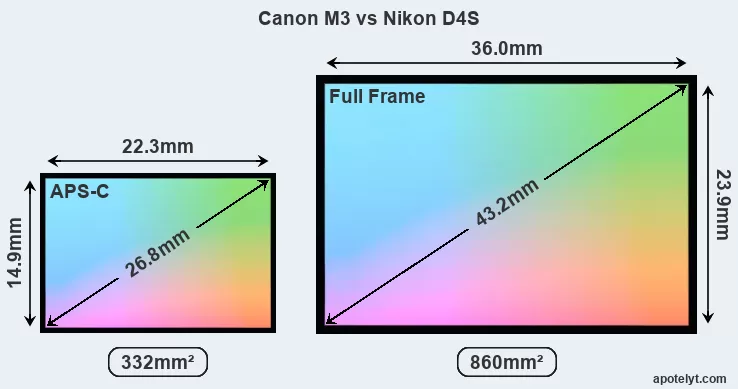
Despite having a smaller sensor, the Canon M3 offers a higher resolution of 24 megapixels, compared with 16.2 MP of the Nikon D4S. This megapixels advantage comes at the cost of a higher pixel density and a smaller size of the individual pixel (with a pixel pitch of 3.72μm versus 7.29μm for the D4S). However, it should be noted that the M3 is a somewhat more recent model (by 11 months) than the D4S, and its sensor might have benefitted from technological advances during this time that partly offset its pixel-size disadvantage.
The resolution advantage of the Canon M3 implies greater flexibility for cropping images or the possibility to print larger pictures. The maximum print size of the M3 for good quality output (200 dots per inch) amounts to 30 x 20 inches or 76.2 x 50.8 cm, for very good quality (250 dpi) 24 x 16 inches or 61 x 40.6 cm, and for excellent quality (300 dpi) 20 x 13.3 inches or 50.8 x 33.9 cm. The corresponding values for the Nikon D4S are 24.6 x 16.4 inches or 62.6 x 41.7 cm for good quality, 19.7 x 13.1 inches or 50.1 x 33.3 cm for very good quality, and 16.4 x 10.9 inches or 41.7 x 27.8 cm for excellent quality prints.
The M3 has on-sensor phase detect pixels, which results in fast and reliable autofocus acquisition even during live view operation.
The Canon EOS M3 has a native sensitivity range from ISO 100 to ISO 12800, which can be extended to ISO 100-25600. The corresponding ISO settings for the Nikon D4S are ISO 100 to ISO 25600, with the possibility to increase the ISO range to 50-409600.
Technology-wise, both cameras are equipped with CMOS (Complementary Metal–Oxide–Semiconductor) sensors. Both cameras use a Bayer filter for capturing RGB colors on a square grid of photosensors. This arrangement is found in most digital cameras.
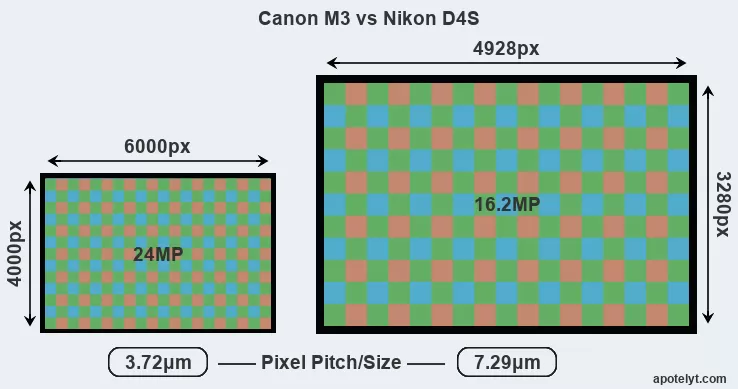
Consistent information on actual sensor performance is available from DXO Mark for many cameras. This service is based on lab testing and assigns an overall score to each camera sensor, as well as ratings for dynamic range ("DXO Landscape"), color depth ("DXO Portrait"), and low-light sensitivity ("DXO Sports"). Of the two cameras under consideration, the D4S offers substantially better image quality than the M3 (overall score 17 points higher). The advantage is based on 1.6 bits higher color depth, 1.5 EV in additional dynamic range, and 1.4 stops in additional low light sensitivity. The following table provides an overview of the physical sensor characteristics, as well as the sensor quality measurements for a selection of comparators.

| Camera Model |
Sensor Class |
Resolution (MP) |
Horiz. Pixels |
Vert. Pixels |
Video Format |
DXO Portrait |
DXO Landscape |
DXO Sports |
DXO Overall |
||
|---|---|---|---|---|---|---|---|---|---|---|---|
| 1. | Canon M3 | APS-C | 24.0 | 6000 | 4000 | 1080/30p | 22.8 | 11.8 | 1169 | 72 | |
| 2. | Nikon D4S | Full Frame | 16.2 | 4928 | 3280 | 1080/60p | 24.4 | 13.3 | 3074 | 89 | |
| 3. | Canon G5 X | 1-inch | 20.0 | 5472 | 3648 | 1080/60p | 21.4 | 12.3 | 471 | 62 | |
| 4. | Canon G7 X | 1-inch | 20.0 | 5472 | 3648 | 1080/60p | 23.0 | 12.7 | 556 | 71 | |
| 5. | Canon M | APS-C | 17.9 | 5184 | 3456 | 1080/30p | 22.1 | 11.2 | 827 | 65 | |
| 6. | Canon M5 | APS-C | 24.0 | 6000 | 4000 | 1080/60p | 23.4 | 12.4 | 1262 | 77 | |
| 7. | Canon M6 | APS-C | 24.0 | 6000 | 4000 | 1080/60p | 23.4 | 12.6 | 1317 | 78 | |
| 8. | Canon M50 | APS-C | 24.0 | 6000 | 4000 | 4K/24p | 23.8 | 13.3 | 1684 | 81 | |
| 9. | Canon M50 Mark II | APS-C | 24.0 | 6000 | 4000 | 4K/24p | 24.0 | 13.6 | 1939 | 83 | |
| 10. | Canon M100 | APS-C | 24.0 | 6000 | 4000 | 1080/60p | 23.5 | 12.9 | 1272 | 78 | |
| 11. | Canon T6i | APS-C | 24.0 | 6000 | 4000 | 1080/30p | 22.7 | 12.0 | 919 | 71 | |
| 12. | Canon T6s | APS-C | 24.0 | 6000 | 4000 | 1080/30p | 22.6 | 12.0 | 915 | 70 | |
| 13. | Nikon D4 | Full Frame | 16.2 | 4928 | 3280 | 1080/30p | 24.7 | 13.1 | 2965 | 89 | |
| 14. | Nikon D5 | Full Frame | 20.7 | 5588 | 3712 | 4K/30p | 25.1 | 12.3 | 2343 | 88 | |
| 15. | Nikon D750 | Full Frame | 24.2 | 6016 | 4016 | 1080/60p | 24.8 | 14.5 | 2956 | 93 | |
| 16. | Nikon D810 | Full Frame | 36.2 | 7360 | 4912 | 1080/60p | 25.7 | 14.8 | 2853 | 97 | |
| 17. | Nikon Df | Full Frame | 16.2 | 4928 | 3280 | none | 24.6 | 13.1 | 3279 | 89 | |
| Note: DXO values in italics represent estimates based on sensor size and age. | |||||||||||
Many modern cameras cannot only take still pictures, but also record videos. Both cameras under consideration have a sensor with sufficiently fast read-out times for moving pictures, but the D4S provides a faster frame rate than the M3. It can shoot movie footage at 1080/60p, while the Canon is limited to 1080/30p.
Feature comparison
Apart from body and sensor, cameras can and do differ across a variety of features. For example, the D4S has an optical viewfinder, which can be very useful when shooting in bright sunlight. In contrast, the M3 relies on live view and the rear LCD for framing. That said, the M3 can be equipped with an optional viewfinder – the EVF-DC1. The following table reports on some other key feature differences and similarities of the Canon M3, the Nikon D4S, and comparable cameras.

| Camera Model |
Viewfinder (Type or 000 dots) |
Control Panel (yes/no) |
LCD Specifications (inch/000 dots) |
LCD Attach- ment |
Touch Screen (yes/no) |
Max Shutter Speed * |
Max Shutter Flaps * |
Built-in Flash (yes/no) |
Built-in Image Stab |
||
|---|---|---|---|---|---|---|---|---|---|---|---|
| 1. | Canon M3 | optional | n | 3.0 / 1040 | tilting | Y | 1/4000s | 4.2/s | Y | n | |
| 2. | Nikon D4S | optical | Y | 3.2 / 921 | fixed | n | 1/8000s | 11.0/s | n | n | |
| 3. | Canon G5 X | 2360 | n | 3.0 / 1040 | swivel | Y | 1/2000s | 5.9/s | Y | Y | |
| 4. | Canon G7 X | none | n | 3.0 / 1040 | tilting | Y | 1/2000s | 6.5/s | Y | Y | |
| 5. | Canon M | none | n | 3.0 / 1040 | fixed | Y | 1/4000s | 4.3/s | n | n | |
| 6. | Canon M5 | 2360 | n | 3.2 / 1620 | tilting | Y | 1/4000s | 9.0/s | Y | n | |
| 7. | Canon M6 | optional | n | 3.0 / 1040 | tilting | Y | 1/4000s | 9.0/s | Y | n | |
| 8. | Canon M50 | 2360 | n | 3.0 / 1040 | swivel | Y | 1/4000s | 10.0/s | Y | n | |
| 9. | Canon M50 Mark II | 2360 | n | 3.0 / 1040 | swivel | Y | 1/4000s | 10.0/s | Y | n | |
| 10. | Canon M100 | none | n | 3.0 / 1040 | tilting | Y | 1/4000s | 6.1/s | Y | n | |
| 11. | Canon T6i | optical | n | 3.0 / 1040 | swivel | Y | 1/4000s | 5.0/s | Y | n | |
| 12. | Canon T6s | optical | Y | 3.0 / 1040 | swivel | Y | 1/4000s | 5.0/s | Y | n | |
| 13. | Nikon D4 | optical | Y | 3.2 / 921 | fixed | n | 1/8000s | 11.0/s | n | n | |
| 14. | Nikon D5 | optical | Y | 3.2 / 2359 | fixed | Y | 1/8000s | 14.0/s | n | n | |
| 15. | Nikon D750 | optical | Y | 3.2 / 1229 | tilting | n | 1/4000s | 6.0/s | Y | n | |
| 16. | Nikon D810 | optical | Y | 3.2 / 1229 | fixed | n | 1/8000s | 5.0/s | Y | n | |
| 17. | Nikon Df | optical | Y | 3.2 / 921 | fixed | n | 1/4000s | 5.5/s | n | n | |
| Note: *) Information refers to the mechanical shutter, unless the camera only has an electronic one. | |||||||||||
One difference between the cameras concerns the presence of an on-board flash. The M3 has one, while the D4S does not. While the built-in flash of the M3 is not very powerful, it can at times be useful as a fill-in light.
The M3 has an articulated LCD that can be turned to be front-facing. This characteristic will be appreciated by vloggers and photographers who are interested in snapping selfies. In contrast, the D4S does not have a selfie-screen.The Nikon D4S has an intervalometer built-in. This enables the photographer to capture time lapse sequences, such as flower blooming, a sunset or moon rise, without purchasing an external camera trigger and related software.
The M3 writes its imaging data to SDXC cards, while the D4S uses Compact Flash or XQD cards. The D4S features dual card slots, which can be very useful in case a memory card fails. In contrast, the M3 only has one slot.
Connectivity comparison
For some imaging applications, the extent to which a camera can communicate with its environment can be an important aspect in the camera decision process. The table below provides an overview of the connectivity of the Canon EOS M3 and Nikon D4S and, in particular, the interfaces the cameras (and selected comparators) provide for accessory control and data transfer.

| Camera Model |
Hotshoe Port |
Internal Mic / Speaker |
Microphone Port |
Headphone Port |
HDMI Port |
USB Port |
WiFi Support |
NFC Support |
Bluetooth Support |
||
|---|---|---|---|---|---|---|---|---|---|---|---|
| 1. | Canon M3 | Y | stereo / mono | Y | - | mini | 2.0 | Y | Y | - | |
| 2. | Nikon D4S | Y | mono / mono | Y | Y | mini | 2.0 | - | - | - | |
| 3. | Canon G5 X | Y | stereo / mono | - | - | mini | 2.0 | Y | Y | - | |
| 4. | Canon G7 X | - | stereo / mono | - | - | micro | 2.0 | Y | Y | - | |
| 5. | Canon M | Y | stereo / mono | Y | - | mini | 2.0 | - | - | - | |
| 6. | Canon M5 | Y | stereo / mono | Y | - | mini | 2.0 | Y | Y | Y | |
| 7. | Canon M6 | Y | stereo / mono | Y | - | mini | 2.0 | Y | Y | Y | |
| 8. | Canon M50 | Y | stereo / mono | Y | - | micro | 2.0 | Y | - | Y | |
| 9. | Canon M50 Mark II | Y | stereo / mono | Y | - | micro | 2.0 | Y | - | Y | |
| 10. | Canon M100 | - | stereo / mono | - | - | micro | 2.0 | Y | Y | Y | |
| 11. | Canon T6i | Y | stereo / mono | Y | - | mini | 2.0 | Y | Y | - | |
| 12. | Canon T6s | Y | stereo / mono | Y | - | mini | 2.0 | Y | Y | - | |
| 13. | Nikon D4 | Y | mono / mono | Y | Y | micro | 2.0 | - | - | - | |
| 14. | Nikon D5 | Y | stereo / mono | Y | Y | mini | 3.0 | - | - | - | |
| 15. | Nikon D750 | Y | stereo / mono | Y | Y | mini | 2.0 | Y | - | - | |
| 16. | Nikon D810 | Y | stereo / mono | Y | Y | mini | 3.0 | Y | - | - | |
| 17. | Nikon Df | Y | - / - | - | - | mini | 2.0 | - | - | - |
It is notable that the M3 offers wifi support, while the D4S does not. Wifi can be a very convenient means to transfer image data to an off-camera location.
Studio photographers will appreciate that the Nikon D4S (unlike the M3) features a PC Sync socket, so that professional strobe lights can be controlled by the camera.
Both the M3 and the D4S have been discontinued, but can regularly be found used on ebay. The D4S was replaced by the Nikon D5, while the M3 was followed by the Canon M6. Further information on the features and operation of the M3 and D4S can be found, respectively, in the Canon M3 Manual (free pdf) or the online Nikon D4S Manual.
Review summary
So what is the bottom line? Is the Canon M3 better than the Nikon D4S or vice versa? Below is a summary of the relative strengths of each of the two contestants.

Arguments in favor of the Canon EOS M3:
- More detail: Offers more megapixels (24 vs 16.2MP) with a 22% higher linear resolution.
- Better live-view autofocus: Features on-sensor phase-detection for more confident autofocus.
- More detailed LCD: Has a higher resolution rear screen (1040k vs 921k dots).
- More flexible LCD: Has a tilting screen for odd-angle shots in landscape orientation.
- Fewer buttons to press: Is equipped with a touch-sensitive rear screen to facilitate handling.
- More selfie-friendly: Has an articulated screen that can be turned to be front-facing.
- More compact: Is smaller (111x68mm vs 160x157mm) and thus needs less room in the bag.
- Less heavy: Is lighter (by 984g or 73 percent) and hence easier to carry around.
- More legacy lens friendly: Can take a broad range of non-native lenses via adapters.
- Easier fill-in: Is equipped with a small onboard flash to brighten deep shadow areas.
- Easier file upload: Has wifi built in for automatic backup or image transfer to the web.
- Easier device pairing: Supports NFC for fast wireless image transfer over short distances.
- More affordable: Was introduced into a lower priced category (90 percent cheaper at launch).
- More modern: Is somewhat more recent (announced 11 months after the D4S).

Reasons to prefer the Nikon D4S:
- Better image quality: Scores substantially higher (17 points) in the DXO overall evaluation.
- Richer colors: Generates noticeably more natural colors (1.6 bits more color depth).
- More dynamic range: Captures a broader range of light and dark details (1.5 EV of extra DR).
- Better low-light sensitivity: Can shoot in dim conditions (1.4 stops ISO advantage).
- Better video: Provides higher movie framerates (1080/60p versus 1080/30p).
- Better sound control: Has a headphone port that enables audio monitoring while recording.
- Easier framing: Has an optical viewfinder for image composition and settings control.
- Easier setting verification: Features a control panel on top to check shooting parameters.
- Larger screen: Has a bigger rear LCD (3.2" vs 3.0") for image review and settings control.
- Faster shutter: Has higher mechanical shutter speed (1/8000s vs 1/4000s) to freeze action.
- Faster burst: Shoots at higher frequency (11 vs 4.2 flaps/sec) to capture the decisive moment.
- Easier time-lapse photography: Has an intervalometer built-in for low frequency shooting.
- More portrait friendly: Features an integrated vertical grip for easier portrait shooting.
- Longer lasting: Gets more shots (3020 versus 250) out of a single battery charge.
- Better sealing: Is splash and dust sealed for shooting in inclement weather conditions.
- Better studio light control: Has a PC Sync socket to connect to professional strobe lights.
- Greater peace of mind: Features a second card slot as a backup in case of memory card failure.
- More heavily discounted: Has been on the market for longer (launched in February 2014).
If the number of relative strengths (bullet points above) is taken as a guide, the D4S is the clear winner of the contest (18 : 14 points). However, the pertinence of the various camera strengths will differ across photographers, so that you might want to weigh individual camera traits according to their importance for your own imaging needs before making a camera decision. A professional wildlife photographer will view the differences between cameras in a way that diverges from the perspective of a family photog, and a person interested in architecture has distinct needs from a sports shooter. Hence, the decision which camera is best and worth buying is often a very personal one.
How about other alternatives? Do the specifications of the Canon M3 and the Nikon D4S place the cameras among the top in their class? Find out in the latest Best Mirrorless Interchangeable Lens Camera and Best DSLR Camera listings whether the two cameras rank among the cream of the crop.
In any case, while the specs-based evaluation of cameras can be instructive in revealing their potential as photographic tools, it remains incomplete and does no justice, for example, to the way the M3 or the D4S perform in practice. At times, user reviews, such as those published at amazon, address these issues in a useful manner, but such feedback is on many occasions incomplete, inconsistent, and unreliable.
Expert reviews
This is why expert reviews are important. The adjacent summary-table relays the overall verdicts of several of the most popular camera review sites (amateurphotographer [AP], cameralabs [CL], digitalcameraworld [DCW], dpreview [DPR], ephotozine [EPZ], photographyblog [PB]). As can be seen, the professional reviewers agree in many cases on the quality of different cameras, but sometimes their assessments diverge, reinforcing the earlier point that a camera decision is often a very personal choice.

| Camera Model |
AP score |
CL score |
DCW score |
DPR score |
EPZ score |
PB score |
Camera Launch |
Launch Price (USD) |
Street Price |
||
|---|---|---|---|---|---|---|---|---|---|---|---|
| 1. | Canon M3 | 4/5 | o | .. | 75/100 | 4.5/5 | 4/5 | Feb 2015 | 679 | ebay.com | |
| 2. | Nikon D4S | 5/5 | .. | .. | .. | 4.5/5 | 4.5/5 | Feb 2014 | 6,499 | ebay.com | |
| 3. | Canon G5 X | 5/5 | + + | .. | 78/100 | 4.5/5 | 4.5/5 | Oct 2015 | 799 | ebay.com | |
| 4. | Canon G7 X | 4/5 | + + | .. | 77/100 | 4.5/5 | 4.5/5 | Sep 2014 | 699 | ebay.com | |
| 5. | Canon M | 3/5 | + | .. | .. | 4/5 | 4/5 | Jul 2012 | 599 | ebay.com | |
| 6. | Canon M5 | 4/5 | + | 4/5 | 82/100 | 4/5 | 4/5 | Sep 2016 | 979 | ebay.com | |
| 7. | Canon M6 | .. | .. | .. | 80/100 | 4/5 | 4/5 | Feb 2017 | 779 | ebay.com | |
| 8. | Canon M50 | .. | + | 4/5 | 79/100 | .. | 3.5/5 | Feb 2018 | 779 | ebay.com | |
| 9. | Canon M50 Mark II | 4/5 | .. | 4/5 | .. | 4.5/5 | 3.5/5 | Oct 2020 | 599 | ebay.com | |
| 10. | Canon M100 | 3/5 | + | .. | .. | 4/5 | 3.5/5 | Aug 2017 | 499 | ebay.com | |
| 11. | Canon T6i | 5/5 | .. | .. | 75/100 | 4.5/5 | 4.5/5 | Feb 2015 | 749 | ebay.com | |
| 12. | Canon T6s | 5/5 | + | .. | 77/100 | 4.5/5 | 4.5/5 | Feb 2015 | 649 | ebay.com | |
| 13. | Nikon D4 | .. | .. | .. | .. | 4.5/5 | 4.5/5 | Jan 2012 | 5,999 | ebay.com | |
| 14. | Nikon D5 | .. | .. | 4/5 | 89/100 | 4.5/5 | 5/5 | Jan 2016 | 6,499 | ebay.com | |
| 15. | Nikon D750 | 5/5 | + + | 4/5 | 90/100 | 4.5/5 | 4.5/5 | Sep 2014 | 2,299 | ebay.com | |
| 16. | Nikon D810 | 5/5 | .. | 5/5 | 86/100 | 5/5 | 4.5/5 | Jun 2014 | 3,299 | ebay.com | |
| 17. | Nikon Df | 4/5 | .. | .. | 81/100 | 4/5 | 4/5 | Nov 2013 | 2,749 | ebay.com | |
| Note: (+ +) highly recommended; (+) recommended; (o) reviewed; (..) not available. | |||||||||||
Care should be taken when interpreting the review scores above, though. The ratings are only valid when referring to cameras in the same category and of the same age. Hence, a score should always be seen in the context of the camera's market launch date and its price, and rating-comparisons among cameras that span long time periods or concern very differently equipped models make little sense. It should also be noted that some of the review sites have over time altered the way they render their verdicts.

Check M3 offers at
ebay.com

Check D4S offers at
ebay.com
Other camera comparisons
Did this review help to inform your camera decision process? In case you would like to check on the differences and similarities of other camera models, just make your choice using the following search menu. As an alternative, you can also directly jump to any one of the listed comparisons that were previously generated by the CAM-parator tool.
Specifications: Canon M3 vs Nikon D4S
Below is a side-by-side comparison of the specs of the two cameras to facilitate a quick review of their differences and common features.
| Camera Model | Canon M3 | Nikon D4S |
|---|---|---|
| Camera Type | Mirrorless system camera | Digital single lens reflex |
| Camera Lens | Canon EF-M mount lenses | Nikon F mount lenses |
| Launch Date | February 2015 | February 2014 |
| Launch Price | USD 679 | USD 6,499 |
| Sensor Specs | Canon M3 | Nikon D4S |
| Sensor Technology | CMOS | CMOS |
| Sensor Format | APS-C Sensor | Full Frame Sensor |
| Sensor Size | 22.3 x 14.9 mm | 36.0 x 23.9 mm |
| Sensor Area | 332.27 mm2 | 860.4 mm2 |
| Sensor Diagonal | 26.8 mm | 43.2 mm |
| Crop Factor | 1.6x | 1.0x |
| Sensor Resolution | 24 Megapixels | 16.2 Megapixels |
| Image Resolution | 6000 x 4000 pixels | 4928 x 3280 pixels |
| Pixel Pitch | 3.72 μm | 7.29 μm |
| Pixel Density | 7.22 MP/cm2 | 1.88 MP/cm2 |
| Moiré control | Anti-Alias filter | Anti-Alias filter |
| Movie Capability | 1080/30p Video | 1080/60p Video |
| ISO Setting | 100 - 12,800 ISO | 100 - 25,600 ISO |
| ISO Boost | 100 - 25,600 ISO | 50 - 409,600 ISO |
| Image Processor | DIGIC 6 | EXPEED 4 |
| DXO Sensor Quality (score) | 72 | 89 |
| DXO Color Depth (bits) | 22.8 | 24.4 |
| DXO Dynamic Range (EV) | 11.8 | 13.3 |
| DXO Low Light (ISO) | 1169 | 3074 |
| Screen Specs | Canon M3 | Nikon D4S |
| Viewfinder Type | Viewfinder optional | Optical viewfinder |
| Viewfinder Field of View | 100% | |
| Viewfinder Magnification | 0.70x | |
| Top-Level Screen | no Top Display | Control Panel |
| LCD Framing | Live View | Live View |
| Rear LCD Size | 3.0inch | 3.2inch |
| LCD Resolution | 1040k dots | 921k dots |
| LCD Attachment | Tilting screen | Fixed screen |
| Touch Input | Touchscreen | no Touchscreen |
| Shooting Specs | Canon M3 | Nikon D4S |
| Focus System | On-Sensor Phase-detect | Phase-detect AF |
| Manual Focusing Aid | Focus Peaking | no Peaking Feature |
| Continuous Shooting | 4.2 shutter flaps/s | 11 shutter flaps/s |
| Shutter Life Expectancy | 100 000 actuations | 400 000 actuations |
| Time-Lapse Photography | no Intervalometer | Intervalometer built-in |
| Fill Flash | Built-in Flash | no On-Board Flash |
| Storage Medium | SDXC cards | CF or XQD cards |
| Single or Dual Card Slots | Single card slot | Dual card slots |
| Connectivity Specs | Canon M3 | Nikon D4S |
| External Flash | Hotshoe | Hotshoe |
| Studio Flash | no PC Sync | PC Sync socket |
| USB Connector | USB 2.0 | USB 2.0 |
| HDMI Port | mini HDMI | mini HDMI |
| Microphone Port | External MIC port | External MIC port |
| Headphone Socket | no Headphone port | Headphone port |
| Wifi Support | Wifi built-in | no Wifi |
| Near-Field Communication | NFC built-in | no NFC |
| Body Specs | Canon M3 | Nikon D4S |
| Environmental Sealing | not weather sealed | Weathersealed body |
| Battery Type | Canon LP-E17 | Nikon EN-EL18a |
| Battery Life (CIPA) | 250 shots per charge | 3020 shots per charge |
| Body Dimensions |
111 x 68 x 44 mm (4.4 x 2.7 x 1.7 in) |
160 x 157 x 91 mm (6.3 x 6.2 x 3.6 in) |
| Camera Weight | 366 g (12.9 oz) | 1350 g (47.6 oz) |

Check M3 offers at
ebay.com

Check D4S offers at
ebay.com
Did you notice an error on this page? If so, please get in touch, so that we can correct the information.
